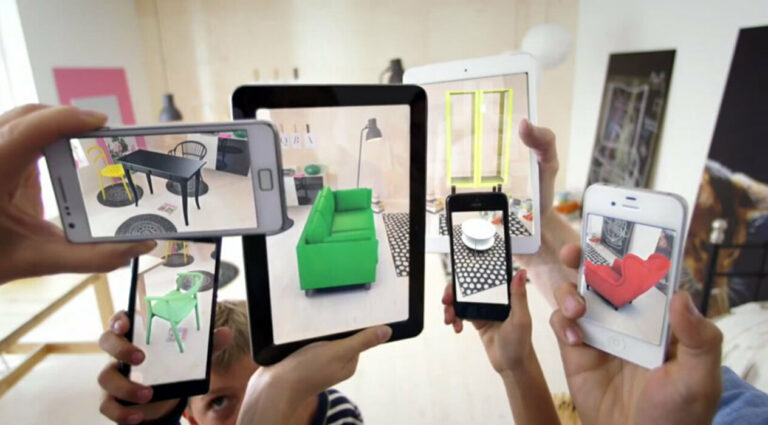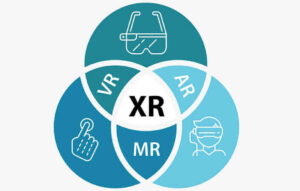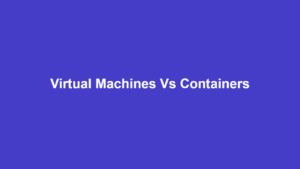6 年 2024 个最佳增强现实框架

增强现实框架是一种软件工具,可让开发人员轻松创建 AR 应用程序。
尽管彼此略有不同,但这些框架都带有必要的工具和组件来处理 AR 软件开发的所有阶段和方面。
它们的独特功能还使一些增强现实框架比其他框架更适合某些应用程序——从投影到基于位置、叠加和混合现实。
本指南向您展示了有关 AR 框架的一切,包括它们的最佳功能以及您可以使用它们做什么。
使用 AR 框架的好处
从游戏到在虚拟商店购物再到探索潜在的新家,增强现实应用程序为最终用户提供了许多好处。 但对于开发人员而言,AR 框架是让生活更轻松的工具,它们的好处包括:
- 效率 – 框架提供了常用的工具和组件,可以帮助 AR 开发人员快速开发应用程序。 这节省了他们的时间和精力,使他们更容易专注于手头的任务。
- 兼容性 – 使用增强现实平台开发应用程序还意味着您将为目标平台生成正确的代码,因为移动和桌面应用程序都需要不同的编码标准和方法。
- 成本节约: – 使用具有所有相关工具的框架可以节省时间并降低应用程序的总体开发成本。
- 可扩展性 – 框架还可以更轻松地创建可轻松扩展的应用程序。
- 社区支持 – 活跃的开发者社区提供资源和共享知识。 因此,使用 AR 框架可以轻松找到志同道合的人,您可以与之互动并向他们学习。
增强现实框架的特点
增强现实框架具有不同的功能,可帮助开发人员为其目标用户创建合适的应用程序。 这些功能包括映射环境、跟踪用户的移动、呈现输出、用户交互以及与其他系统的集成。
- 跟踪 – AR 跟踪过程涉及检测和跟踪与用户设备相关的真实世界对象位置和方向。 跟踪对于产生准确的输出是必要的。
- 地图绘制 – 这是创建用户物理环境数字地图的过程,使用从传感器到算法的不同方法。
- 渲染 – 这是将生成的计算机模型转换为可见图像的过程。 渲染通常以 3D 形式完成。
- 用户互动 – 这包括用户界面的制作和输入的后续处理。
- 系统集成 – 一个好的 AR 框架将包含可以轻松连接到其他应用程序、API、引擎或服务的模块。
6 大增强现实框架
以下是增强现实开发的顶级框架。 请注意,其中许多还与 Unity 和 Unreal 等游戏引擎很好地集成。
1. 增强现实
亮点: Android平台,运动追踪,光照估计,免费,Unity,Unreal
ARCore 是 Google 的软件开发工具包 (SDK),面向 Android 平台上的增强现实开发人员。 它于 2018 年 7.0 月首次发布,适用于 Android XNUMX 及更高版本。
该平台提供对象遮挡、交互和沉浸感。 还有光估计和环境理解,再加上云锚 API,可以很容易地与 iOS 等其他平台共享和交互。
2.ARKit
亮点: 适用于 iOS 和 iPadOS,广泛的功能和其他工具
网址: developer.apple.com/augmented-reality/arkit
ARKit 适用于 iOS 和 iPadOS Apple 系统的开发人员。 它是 Apple 的 AR 工具主机的一部分,这些工具还包括 RealityKit、Reality Composer 和 Reality Converter,供技术水平较低的人使用。
ARKit 目前是第 6 版,具有 4k 视频功能、许多城市的定位锚、图像和视频捕捉改进、深度 API、人物遮挡、动作捕捉、光照估计以及更多功能。
3.Vuforia
亮点: 免费增值计划、跨平台、云服务
网址: 开发者.vuforia.com
Vuforia 是一个企业级增强现实软件开发套件,其中包括可在 Android、iOS 和 Windows 10 平台上运行的跨平台 Vuforia 引擎。 它可作为免费增值服务提供,免费计划包括无水印的无限开发和发布。
基本计划还包括云服务,每月免费提供多达 1,000 个图像目标和 1,000 次识别。 还有一个高级相机 API 和多目标功能。
4.EasyAR
亮点: 免费增值计划、多目标跟踪、Unity3d
网址: 易雅网
EasyAR 是一个增强现实引擎,而 EasyAR Sense 是面向开发人员的独立 SDK。 它带有图像跟踪、对象跟踪、表面跟踪、稀疏和密集空间地图、碰撞、遮挡和更多功能。
EasyAR Sense 有 4 个订阅计划。 有 个人方面 供个人、非商业用途免费使用的版本。 它包括水印并限制某些功能。 然后,有 专业化 每月 39 美元起的版本,以及 经典卡 和 企业 版本。
5。 库丹
亮点: Android & iOS,标记跟踪器,无标记
网址: xlsoft.com/en/products/kudan/index.html
Kudan AR SDK 是一项免费增值服务,支持在 iOS 和 Android 平台上开发具有标记和无标记跟踪功能的移动增强现实。
它还带有 Unity 插件和高级渲染功能,可免费构建和测试您的应用程序。 然而,对于商业用途,有两个生产许可证可以以一定的价格删除系统的水印。
6.意志力
亮点: Geo AR,多跟踪,iOS,Android,Windows
网址: 维基百科
Wikitude 适用于 Android、iOS 和 Windows,具有即时跟踪、地理 AR、图像、对象和即时跟踪等功能,并支持 Unity、Flutter 等。
Studio 编辑器可以无代码工作,非常适合非程序员。 它还包括场景跟踪、云识别、圆柱体跟踪,甚至为企业用户提供智能眼镜支持。 Wikitude 的一次性许可费用为 2,490 欧元,订阅费用为每年 1 欧元。
增强现实系统的类型
根据增强现实系统与用户的交互程度和沉浸感,有 6 种主要分类。 它们如下:
- 基于标记的增强现实– 这种类型的增强现实使用二维码等物理图像来激活交互式增强现实体验。 此应用程序类型可用于创建更详细的对象演示或从更多角度查看对象。
- 基于无标记的 AR – 与上述基于标记的系统相反,基于无标记的增强现实系统不需要外部图像或标记识别来触发它们。 无标记系统依靠相机、地理定位、加速度计、陀螺仪、磁力计和立体视觉等传感器来检测和跟踪用户的环境。
- 基于投影的增强现实 – 这种类型的 AR 应用程序使用投影仪将其输出显示到用户环境中的物理表面上。 基于投影的系统可用于创建大型显示,例如用于汽车销售或产品揭幕。 计算机可以扫描环境以挑选出最佳的投影表面,还可以通过允许用户触摸和手势控制来使其更具交互性。
- 基于位置的增强现实 – 顾名思义,基于位置的 AR 系统依赖于用户的地理位置和方向来显示相应的数字内容。 此类应用适用于博物馆和历史遗迹,可以在特定位置显示额外信息。 不利的是,此类 AR 系统通常在智能手机中使用 GPS 坐标,这意味着您只能在您位于该确切位置时才能获得输出。
- 叠加AR – 叠加增强现实创建了一个对象的数字版本,可以实时部分或完全替换该对象。 该系统使用对象识别来创建集成为原始对象物理环境一部分的数字版本。 智能手机和 AR 耳机都可以用于创建具有丰富反馈和用户交互的此类体验。
- 基于轮廓的增强现实 – 基于轮廓或轮廓的增强现实使用现实世界对象的轮廓或轮廓来创建其数字输出,可以以多种方式使用。 基于轮廓的系统通常依靠相机或特殊传感器来获取物体上的这些轮廓。 它们主要用于开发自动驾驶汽车系统。
常见问题解答(FAQ)
如何为我的项目选择合适的 AR 框架?
您将需要进行一些初步考虑,例如您需要在应用程序中实现的功能、您需要运行该应用程序的平台以及您需要的支持级别。
增强现实框架能否同时创建移动和桌面应用程序?
大多数增强现实框架都是为特定平台上的开发而设计的。 但是,某些框架(如 Vuforia)可以在移动和桌面应用程序上运行。
增强现实的局限性是什么?
这可能包括复杂的开发过程、对专用硬件的需求以及用户在使用过程中的迷失方向。
ARKit 和 ARCore 有何不同?
ARKit 是为在 iOS 设备上开发而设计的,而 ARCore 是为在 Android 平台上开发而设计的。
我可以在一个应用中同时使用 ARCore 和 ARKit 吗?
您将必须为其支持的特定平台选择每个框架。 如果您想要一个适用于 Android 和 iOS 平台的框架,您也可以选择 Vuforia。
结论
我们已经完成了本指南的结尾,介绍了增强现实世界及其最流行的工具。 正如你所看到的,AR领域有很多大品牌。
你从这里去哪里取决于你。 但要知道增强现实仍在增长,所以谁知道下一件大事会是什么?





